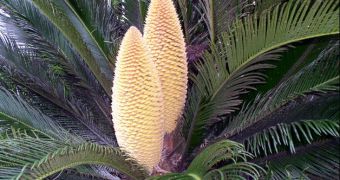Cycad palms are some of the oldest trees on Earth. Even if they resemble a palm tree, they are much more primitive, being gymnosperm related to the coniferous trees. They appeared 280 millions year ago, when reptiles were just evolving from amphibians, and dominated the Earth for a long time during the dinosaur era till the emergence of the modern flower plants. Now they are just relict in the planet's warm areas.
A new research made on an Australian cycad surprised through a complex system of animal pollination, in which they selectively attract and repel small primitive insects called thrips.
It has always been believed that the cycads were passively wind-pollinated, like the other gymnosperms, with their pine-like cones. But male cones were found to use a push-pull system to ensure active insect pollination, while female cones expel an attractive scent to lure the insect back in. "I think the work demonstrates that plants aren't just sitting there looking pretty or just smelling good to attract their pollinators and that there's a lot more dynamics involved", said co-author Irene Terry, a biologist at the University of Utah.
The young male cone is green but, with age, it becomes yellow. The young female cone is green, but changes to a reddish hue following fertilization. Tiny cracks in the male cone between the tightly woven scales give thrips access to pollen. Thrips, both adults and larvae, eat just pollen, and they prefer the male cones. "Twenty-five years ago when I began studying cycad pollination, it was still widely believed that cycads, like other gymnosperms, were wind-pollinated," said William Tang, an entomologist with the U.S. Department of Agriculture, not involved in this research.
"Although I was involved in some of the early studies on cycad insect behavior, cone physiology, and odor analyses that supported the notion of insect pollination in this group, the precise details of this mutualism remained a nagging mystery," added Tang.
Cycads possess irregular pollination periods, once a year to once every several years, and the reproductive period can last up to 4 weeks, when male cones store carbohydrates and fats, increasing their temperature up to 100? F (38? C), while emitting huge amounts of a foul chemical named beta-myrcene. "The odors get so strong that I don't want to be around them. Some plants produce a stinky odor like a dead animal or poop, but this odor is just very harsh, hard to describe in terms of something similar." said Terry.
"Beta-myrcene attracts thrips at low concentrations, but in the amounts emitted by male cones, it becomes highly repellent," said Robert A. Raguso, a chemical ecologist from Cornell University, not involved in this research. "This is a rather emphatic invitation for the thrips [to] leave home, and they do so bearing pollen. The plants do this without dramatically changing their structural or visual characteristics, or even the chemistry of their scent," he added.
Female cones too spread beta-myrcene, but in a lower concentration that lures the fleeing thrips. When entering though the cracks into the female cone, the thrips will be headed towards the ovule, which releases a droplet of a nectar-like stuff. This way, they accomplish the pollination. "The [study] highlights an elegant physiological mechanism by which cycads manipulate the behavior of thrips, transforming them from neutral or perhaps detrimental pollen predators to helpful pollinators", said Raguso.

 14 DAY TRIAL //
14 DAY TRIAL //